March 2002 Newsletter
March 2002 Newsletter
Issue No. 207
Under the Patronage of H.E. Sheikh Nahyan Bin Mubarak Al Nahyan
Contents
- Share your news and discoveries
- Chairman's Note
- Archaeology
- Shutterbugs
- Programme
- Plant Life
- Bookworm
- Reptiles
- Lady Marmalade
- T-Shirt
- Bug Business
- Inter Emirates Weekend
- Field Trips
- Volunteers
- Twitchers' Corner
- Membership
- ENHG Committee Members 2001-2002
Share your news and discoveries
This newsletter is published free and is circulated to more than 130 members in the Al Ain area. If you are planning an activity please notify the Editor so other members can be involved. Remember everybody is able to contribute to Emirates recordings. For further details of items listed in this newsletter visit our website at: /index.html or join our e-mail discussion group.
Return to top of page
Chairman's Note
by Brien HolmesMany of our members are already aware that the upcoming Inter-Emirates Weekend (10/11 Apr) will be a proud occasion for the Al Ain chapter. Two of our members will receive awards in recognition of their outstanding contributions to the work of naturalists here in UAE.
Our Recording Officer, Peter Cunningham, will receive The Sheikh Mubarak Award for his study of the Spiney Tailed Lizard (Dhub) and other local wildlife. The gravel plain among the dunes is home to several dozen Dhubs and is a place where Peter has spent countless hours recording every aspect of the lizard's life. He has also spent much time on Jebel Hafit recording wildlife and observed a Tahr on the mountain last year, this was a very rare sighting indeed. Peter has also conducted research on wadi fish.
For almost 20 years, one man gave up two weekends every month to take our members to some of the most beautiful and amazing places in UAE. For his unselfish contributions, Ibrahim Zakhour was made a lifetime member of Al Ain chapter last October and all chapters of ENHG will now honour Ibrahim's contributions by presenting him with The Bish Brown Award.
Both of these awards are richly deserved and I know that all our members are thrilled that the organisation is officially acknowledging the contributions of these two individuals.
Return to top of page
Archaeology
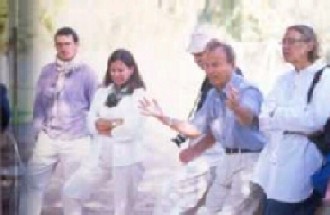
Re-excavation of Umm an-Nar Pit Grave at Hilli
by Dr Sophie Mery
A fourth season of excavation is held in January and February 2002 at Hili Tomb N (Eastern region, Emirate of Abu Dhabi) by the Department of Antiquities and Tourism in Al Ain in collaboration with the French Archaeological Mission in the U.A.E, under the co-direction of Dr Walid Yasin al Tikriti from Al Ain and Dr Sophie Méry from CNRS-France. Most of the contents of the grave were originally excavated by a team from the Department, who decided in 1989 to leave a part of the burial deposits in the central part of the structure, untouched.
The main aim of the re-excavation of Tomb N is to increase our understanding of local funerary practices, with the help of field anthropologists, this year Esther Gatto and Gautier Basset, and Kath McSweeney, an ostearchaeologist who is also examining the human bones from the original excavations. Tomb N at Hili, being a pit-grave, is different from the classic monumental circular Umm an-Nar graves nearby, not only in shape and techniques of construction, but also in the internal distribution of the bone deposits. It contained the remains of more than 400 individuals (including men, women and children of all ages) and the 1.7 metres deep funerary deposits result from a long sequence of changes over a long period of use (around 200 years).
The new excavations at Hili N have led the joint team to conclude that the grave was not used as a simple ossuary, as previously thought. The presence of primary inhumations, and intentional cremation in some areas of the grave, has now been established, however, it is possible that the bones from the bottom level of tomb had been moved from their original burial place in the adjacent circular Tomb E. Partial skeletons of 14 different adults have so far been identified as well as thousands of disarticulated bones. It is not always possible to identify the exact position of the articulated bodies, but the arm of one individual was tucked up with a hand under the cheek.
A large proportion of the dead were from unborn foetuses or newly-born babies, suggesting problems during pregnancy and childbirth. Only a few adults lived beyond 40, and almost all had lost several teeth by the time they died. Evidence of periods of disease or malnutrition, occurring during childhood, can be seen in the teeth of many people. The skulls of some children showed changes possibly related to a deficiency in their diet, such as iron or vitamin C or D. It is unlikely that vitamin deficiency would in itself have been the cause of death, but a poor diet could have facilitated infection or disease, and so could indirectly have led to an early death.
With the exception of one skull with an injury which may have been caused by a blow to the head, there is little evidence for violence. It is expected that the continuing excavations of Tomb N will provide a greater insight into the lifestyle of the people who lived at Hili 4000 years ago.
Return to top of page

Shutterbugs
Camel Race & Visit to CVRL
by Jerry Buzzell
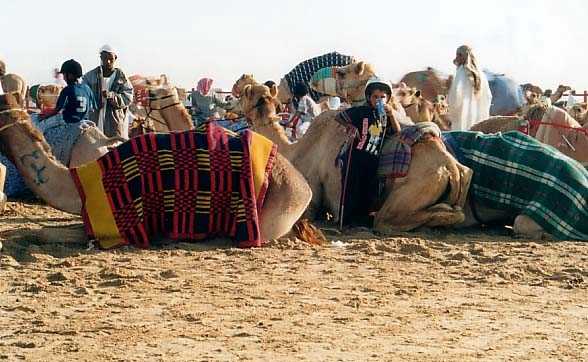
On 3 Jan 2002, were met by Dr Ulrich Wernery, Director of the Central Veterinary Research Laboratory (CVRL) in Dubai. After introductions we drove to the practice race track, taking pictures of the busy traffic of: camels, jockeys, and handlers passing in both directions, along with the ubiquitous pickup trucks and 4x4s. We were introduced to the concept of the 'lead camel' - an older beast that accompanies the racer, calming and guiding it.
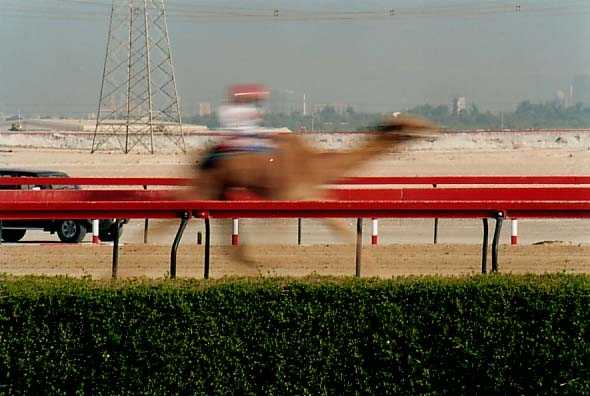
The 'practice track' is a long stretch of racetrack, where camels and jockeys exercise and train. Most were running in small groups of 5 or 6 camels and the jockeys seemed to be having a good time waving and 'hamming-it-up' for spectators. We progressed past the assembly area to the urine collection area...Dr Wernery explained that the first 3 camels in each race are brought to this enclosed area, and one or more of them is randomly selected for urinalysis. A specially designed collection bag (suitable for both male and female anatomy) is strapped to the camel and the samples taken to the CVRL for analysis.
Urine analysis was initiated five years ago on order of General Sheikh Mohammed bin Rashid al Maktoum, Crown Prince of Dubai. Early in the program, caffeine was most commonly used for doping as handlers would slip the camel coffee to 'pep' them up before the race. That practice appears to have stopped, and no drugs have been found for the past three years.
We moved to the grandstand to watch a couple of races that were run over 5 km, on a large oval track. The Racing camels, and lead camel, were paraded past the grandstand and to the starting point. Suddenly the gate lifted and then they were off...Owners in pickups and 4x4s sped frantically along a parallel track towards the periphery, along with the camera trucks.
The race was simultaneously broadcast on large screen TVs at the front of the grandstand with a commentary in Arabic. The majority of the race was only visible from these TV screens, or as a distant dust cloud...until the camels, accompanied by their motor posse, entered the final stretch. Then they galloped past the grandstand to the finish in a flash, accompanied by exhortations and cheers from the watching throng.
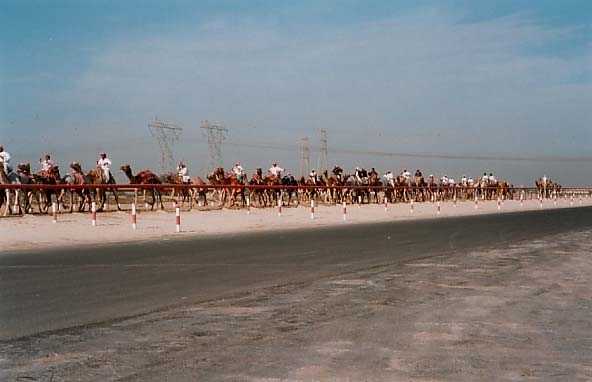
Camel races provoke a mixed reaction from western expatriates and our group was no exception.
The Jockeys are usually slightly built, very young boys, and this can be an emotive issue. The youths seemed happy with their lot and one must be mindful of the environment many have left behind. Apparently the worst abuses of the system have been eliminated by strict regulations but such things never seem truly black or white.
We returned to the practice track for the spectacular sight of hundreds of camels running together. Dr Wernery had never seen so many racing at one time. He guessed the races had stacked-up so when the official race was run, and the obstruction lifted, it was as if a dam had broken. It was indeed a remarkable sight and an occasion for some striking photos.
The CVRL is situated beside Sheikh Mohammed's Zaabeel Palace, and it's location emphasises the importance that the Sheikh attaches to animal health. It is a series of low buildings, with diagnostic laboratories as well as animal hospital sections and office and library space. We assembled in the library and enjoyed a customary glass of camel milk while Dr Wernery spoke of the lab, its history, mission, and of 'green grass sickness', which killed Dubai Millennium last year. He also discussed the rules and regulations (local & international) governing the import of racehorses into the UAE and the laboratory's pivotal role in meeting them.
Two assembled camel skeletons warranted close inspection and comments. We were told that the labs were quiet as it was the weekend although work was on-going. The drug testing section and forensic sections are closed to the public. No autopsies were being conducted but we were permitted to inspect these facilities and the incinerator. Sheikh Mohammed equips the CVRL with 'state of the art' analytical and diagnostic equipment, which impressed those of us who manage with less! After touring microbiology, biochemistry, histopathology and hematology labs, we inspected the "Chamber of Horrors" - an array of pathological specimens and other biological curiosities.
Dr Wernery and CVRL are keen to foster ties with individuals and institutions with common areas of interest. Laurence Garey has already embarked upon a research project with them, examining camel brain anatomy. It is hoped that more collaborative scientific, or veterinary projects, will be taken-up in the future.
Return to top of page
Programme
| Date | Time | Subject/Event | Speaker |
| 1/3 Apr | 20:00 | Horticulture in a Harsh Environment | Peter May |
| 11-12 Apr | weekend | annual Inter-Emirates meeting - hosted by Abu Dhabi chapter | various activities |
| 16 Apr | 20:00 | Spiney Lizard (Dhub) | Peter Cunningham (Recording Officer) |
| 25 Apr-4 May | 17:00 | Al Ain Flower Festival | Static display open to public |
| 30 Apr | 20:00 | Desert Survival Tips: includes a discussion of vital equipment to carry in your car and on your person, first aid and much more! | Earl Dunn, Murphy Turner and others |
| 14 May | 20:00 | TBC ?Marmalade Tasting Challenge | .. |
| 28 May | 20:00 | Spring Photography Competition: TRACKS | .. |
Please note: This programme is correct at time of going to print. Occasionally it is necessary to make amendments and these will be notified to members by e-mail as soon as practical.
Return to top of page

Plant Life
Where Do Plants Come From?
by Geoff Sanderson
From earliest recorded history and from recent discoveries by archaeologists at Hilli, we know that plants were cultivated in this region, using irrigation, from the Bronze Age. It is likely that evidence of plant cultivation from Mesopotamia and in Jordan, circa6000BC, could also be found here. Wheat and barley were grown at Hilli from BC3000 and it is suspected that the Date Palm followed shortly after. The falaj system at Bida-bint-Saud and at Hilli give clear evidence that grains and probably some leaf crops, were in cultivation. These crops began in Jordan and Mesopotamia and quickly spread to other parts of the Arabian Peninsula, especially Yemen and southern Oman where it is known that camel caravans carried grain and dates to the Eastern Mediterranean.
When did the mango, papaya, tomato, potato, onion, garlic, pomegranate, citrus and fig become added to the diet? The eating fig could have been harvested wild as long ago as the early stone age. The pomegranate came from the Persians, and could also have been part of earliest cultivation, similarly, the onion. Plants from the Americas, such as the potato, tomato, capsicum and aubergine (all Solonacae family) may have arrived with the Portuguese in the 15th century AD. They also brought the Mango and Guava from India at around the same time. Papaya, citrus and banana came from south east Asia, possibly via the Dutch traders who came to Zanzibar when it was ruled by Omani's. Citrus fruit in its various varieties was widely distributed by both the Portuguese and Dutch to provide vitamin C on long sea voyages and prevent scurvy.
The Date has been here from at least the Bronze Age and the Sidr is a native species that, along with the fig, would have provided an excellent source of nourishment for nomadic tribes.
The old oases are dis-organised and lack the regimentation expected with farming. Such farms evolved as trees developed and provided shade and shelter for other species - order giving way to logic. For example we can now see at Wadi Jazeera oasis, bananas in random clumps surrounded by Date Palms and huge, individual mango trees. Citrus of three different varieties appear where they have thrived; Papaya enjoy the shelter of Date Palms but have possibly grown from seed wherever they too have found conditions which suit them. Date Palms grow old and die and are replaced by young palms nearby but without any sense of linear order.
Return to top of page

Bookworm
The GREEN GUIDE to the Emirates by Marycke Jongbloed (2ndEdition)
ISBN 1 86063-071-5
Reviewed by Kath Morrison
The quote from the cover of the first edition of this book - "An environmentally friendly guide to little known places of beauty and interest" - aptly summarises the aims of this book, although the places described are probably now far better known than they were 10 years ago. The book is pitched at a general audience, and is a good introduction to those new to the region, including as it does easy to understand sections on the fascinating geology and archeology of the area. I found its anecdotal style easy to read, while still containing sufficient detail to complete the walks and drives described. Marycke has described a particular day in each section, which, in relation to fauna and flora described, results in details of what you might see, rather than what you definitely will.
The book is portable, ring-bound and printed on glossy paper. It is reasonably durable (our first edition has languished in the book bag in the car for several years, and is still in reasonable condition!). References to other books of a similar nature, such as the "Off-Road" series would be helpful. Although the book is sponsored this does not impinge on the text.
Little has been changed in the second edition - a necessary re-write of the Hatta to Kalba section plus modifications to the map, a new section on the Arabian Leopard Trust, and the Zoo Walk has been omitted. The other sections remain reasonably durable. Alongside lots of photographs of trees & fauna there are many line drawings of plants & flowers; it would be great for identification purposes if these could be colour photographs, but it would add substantially to the cost of the publication, there is probably sufficient material for a completely separate book (hint, hint).
In summary, an enjoyable and useful book, especially for 'newcomers' to the UAE.
Return to top of page
Reptiles
by Peter Cunningham
Herpetological Conference
The 4th World Congress of Herpetology was held 2-9 Dec 2001 in Bentota, in Sri Lanka. Just over 300 delegates from across the continent attended this conference, held every 4 years. Canterbury, Melbourne and Prague were the previous venues.
The scientific programme included topics such as behavioral and morphological asymmetries, ecology, evolution, habitat fragmentation and conservation, medical and veterinary issues, phylogeny, predator-prey interactions, reproduction, social aggregation, snake bites and feeding behaviour as well as tortoise and turtle matters. An in-conference tour was conducted to a local turtle hatchery and a boat cruise to see the local monitor lizards dozing in the mangrove swamps and which reach up to 2 m in length.
I attended the conference as a relative novice, compared to the "who's who" in herpetology, and presented a paper on the feeding ecology of the Spiny-tail Lizard (Uromastyx aegyptius microlepis or "Dhub") from the UAE. Spiny-tail Lizards are large ground dwelling herbivorous (plant eating) lizards found on gravel terrain and inter-dune compact soils throughout the UAE, although nowhere common. Judging from my study population, in the Al Ain area, plants favoured include the coarse desert grasses (Pennisetum divisum and Stipagrostis plumosa) as well as the evergreen herbs, Moltkiopsis ciliata and Monsonia nivea. Perennial plant species form the basis of their diet in the UAE while most other Spiny-tail Lizard studies indicate their preference for annual plant species. This can however be ascribed to the lack of rain in the study area since initiating this study in May 1999. The lizards are also almost exclusively herbivorous with arthropods making up less than 1% of their diet compared to 6% for Uromastyx acanthinura (another Spiny-tail Lizard species from Morocco).
Post congress tours to a number of nature reserves were also on offer. I chose Yala and Bundala National Park's (the latter a Ramsar Wetland) located in the "dry" (rainfall only 700mm p.a.) southeastern part of the country. These Park's are rich in birds, most unfamiliar to me, such as: the Indian Pitta, Open-bill and Painted Storks, Purple Coot, Great Stone Plover and Pheasant-tailed Jacana, to name a few. Elephant, Buffalo, Chital (Spotted Dear), Samba Deer and even the elusive leopard were evident. Interestingly, the first park warden of Bundala National Park was a South African who was interned in the vicinity as a prisoner-of-war during the Anglo-Boer War of 1899-1902.
With 176 species of reptiles and 59 species amphibians (highest species density in South Asia - 55% are endemic), Sri Lanka is a must for reptile enthusiasts. It is with sincere appreciation that I thank the ENHG - Al Ain Chapter, for partially funding my Spiny-tail Lizard studies and making my attendance to the conference possible.
Peter can be contacted by e-mail on: pcunningham@polytechnic.edu.na
Return to top of page
Lady Marmalade
'Trini' oranges (bitter ones) are now available from the Central Suq near the Co-op. ENHG members are busy brewing their entries for the forthcoming Marmalade Competition. The date has yet to be confirmed but has been tentatively set for 14 May.
Return to top of page
T-Shirt
A proof of Al Ain chapter's own, ENHG T-shirt, has been produced. It is a white plain style 180gsm cotton shirt with green silkscreen printing on front only. It would be available in a variety of sizes, for the very reasonable sum of 20dhs!! It is hoped that these can be offered for sale before the inter-emirates weekend. The Committee are presently deciding whether to give approval for an order to be placed.
Return to top of page

Bug Business
by Brigitte Howarth
The next big commitment for the Arthropods SIG is preparing a talk for the Abu Dhabi Natural Interest Group in April, and preparing an event during Inter-Emirates weekend.
Brigitte has finally received a wonderful box of tricks that contained a 'Malaise' trap, a special type of insect trap that intercepts flights of insects and then collects them in a container. Often one finds specimen in such a trap, which were not seen during a visit to a site! This will give us further insight into the dynamics of the insect fauna and can easily be assembled 'in situ' as it resembles a tent. Thus, the next Arthropod trip will utilise the new trap as a trial run before the Inter-Emirates weekend.
The collection is growing week by week. With a couple of boxes ready for use, it will be possible to prepare more specimen for display.
Tephritoidea (Picture Wing Flies)
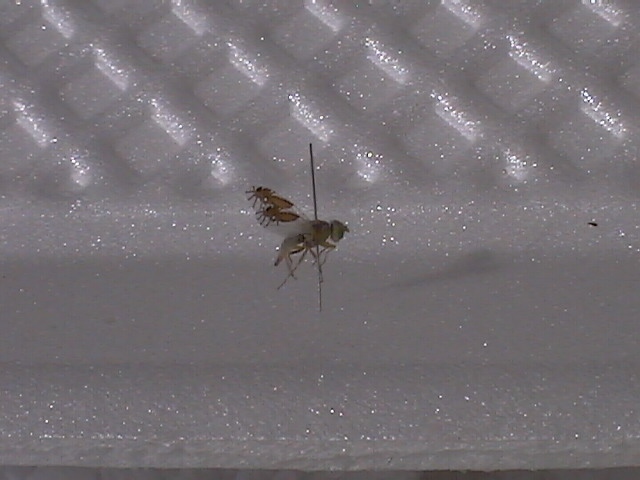
The specimen was first detected on a Ficus. It is possible that this fly, sometimes also referred to as a fruit fly or picture wing fly, is actually utilising the plant. Larvae live in fruit and other parts of plants and often induce gall formation (growth of cells that provides the fly with food and protection) which is actually harmful to the plant.
The fly had very irridescent green eyes but a dull coloured body and transparent wings apart from the pattern on the wings.
The patterns resemble other tiny insects and might be a way the fly protects itself from predators. Potential predators are distracted with disruptive colouration, causing a momentary lapse of concentration and time to escape.
Such a specimen is of interest merely because of its unusual wing colouring. Understanding what may have caused this pattern to evolve can only be guessed at. Certainly such a pattern would aid protection but that alone would be insufficient evolutionary pressure.
The flies have interesting mating rituals where the males wave their wings to attract the attention of females.
A combination of: receiving additional protection with patterns evolving to resemble another insect, and being more successful in passing on genetic material to the next generation may be sufficient evolutionary pressure for such a development.
Brigitte Howarth posted a note of her finding on the internet and various colleagues responded with suggestions identifying the species of Tephritoidea.
The most helpful was from Dr Andy Whittington, of the Geology & Zoology Dept of National Museum of Scotland. who believes that it is Goniurellia spinifera. Brigitte suspects that it is the very similar Goniurellia tridens. To be certain of the identity, Dr Whittington believes it would be necessary for him to examine the specimen himself.
Highly variable patterns are found in Tephritoidea with as many as 7 different varieties having been recorded worldwide. Evidence of identification was supplied by Dr Whittington in a paper on Tephritoidea by Friedberg, 1981. This paper refers to 4 species with very similar wing patterns found in Israel.
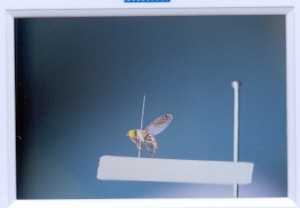
Dr Whittington states there are particular patterns that are repeated several times in phylogenetically separate genera (or families). Other patterns broadly fit a sort of global pattern. The pattern indicated by the photograph would seem to be Goniurellia spinifera and the type of pattern is described as 'radiate'.
Dr Whittington comments that in Platystomatidae there is debate about what the pleisiomorphic character state is: wing completely dark, or completely hyaline. He says it might be interpreted as either.
Goniurellia spinifera is distributed in Israel, Saudi Arabia, Aden, Egypt, Sudan and Ethiopia. Athough records have been made of Tephritoidea in neighbouring countries, it is uncertain whether the fly has previously been recorded from the UAE. Peter Cunningham the ENHG Recording Officer has been contacted to confirm this.
It has been a very exciting and inspiring experience for the Arthropods SIG to find a specimen in the field, which has attracted such extraordinary interest.
Return to top of page
Inter Emirates Weekend
This year is hosted by Abu Dhabi Chapter and takes place over the weekend of 10/11 April. Accommodation can be booked at the Mafraq Hotel on 02 5822666. It is imperative to quote ENHG when booking, to claim the discounted room rate.
Steven James and his colleagues have arranged an exciting selection of trips and activities for our enjoyment, for more information contact: Stephen.james@zu.ac.ae
- Boat Trip off Raha Beach Area into the Channels & Mangroves of Eastern Abu Dhabi Island (3.30pm 10th Apr)
- Desert Ecology & Mammal Catching Trip (3.30pm 10th Apr or 08.30am 11th Apr)
- Futaisi Island (8.30am-2pm 11th Apr - or all day)
- Dhow Trip from Intercontinental Hotel, Abu Dhabi (8.30am-2pm 11th Apr)
There are limited numbers on some of the trips so you are advised to book early. The programme will be further enhanced by events organised by our own members and details will be published in due course. Inter-emirates activities are always well attended and this promises to be a very enjoyable weekend with the chance to make new friends & catch up with old ones! Look forward to BBQ supper arranged for Thursday evening.
Return to top of page
Field Trips
- 11-12 Apr: Inter-Emirates weekend hosted by Abu Dhabi chapter
- 25 Apr: Traditional Food Cooking Day with Miriam Al Dhaheri. In the morning, no more 10 members will accompany her to market to buy ingredients and learn about the methods of preparation. In the evening other members will be able to join them to consume the feast.
Trips are organised for members of the Emirates Natural History Group. Guests may attend if space permits. If you wish to join a particular group on a field trip please sign-up on the appropriate sheet at one of the regular meetings
PLEASE SIGN ONLY IF YOU PLAN TO ATTEND AS NUMBERS MAY BE LIMITED. TOUR ORGANISERS DONATE THEIR TIME, VEHICLES AND EXPERTISE, AND YOUR CO-OPERATION IS VERY MUCH APPRECIATED
Return to top of page
Volunteers
If you have a few hours to spare per week why not volunteer for a position on the Committee or Co-ordinate a SIG (special interest group)? No experience is required and all assistance is gladly received - could you arrange a field trip? It's a great way to make new friends!
Return to top of page
Twitchers' Corner
Little Bells & Big Jessies
by Mark Newson-Smith
Some academics have suggested that falconry dates back to the last Ice Age and the repeated presence of bones from large birds of prey in site in the Middle East dating back up to 12,000 years indicates that such birds were captured and trained to hunt for man.

In the Emirates falconry continues to be a popular pastime among men of all levels of society. The Saker falcon is the favorite bird used by Arab falconers in the UAE. They vary in colouration and can be anything from light brown (on a cream background) to dark brown. Females, which are larger than the males, are referred to as "Hurr" (meaning noble or free), while males are known as "garmoosha".
The Gyrfalcon, a large Arctic falcon thought to be a close relative of the Saker falcon, is highly prized in the Emirates. The bird in the picture had just been bought for over 40,000 dirhams and was thought to be a bargain! The Gyrfalcon is the largest falcon in the world with beak to tail tip ranges of 46-53cm, an average weight of 1000g for males, and large females weighing 2,100g. The Gyrfalcon is capable of a speed of 160km/hour in level flight.
The Peregrine falcon is almost as popular as the Saker in the UAE. It is believed to be the world's fastest creature and in a dive it has reached speeds of over 300 km/hour. There are 22 sub-species of Peregrine and, in adult birds, their size ranges from less than 12.5cms to over 48cms with weights ranging from 450g to 1,200g.
In order to safely restrain the falcon tethers known as Jesses or by Arab Falconers as "subuq" are fitted to each ankle. The bird in the picture is on a portable perch called a "wakir". In the UAE falcons are held on a padded tube that fits over the hand and wrist and is called a "mangalah". In other parts of the Gulf a gauntlet, called a "dass", is used. The hood, known as a "burqa" is used to keep the falcon calm.
Recommended reading to learn more about falconry in the UAE is: "Falconry and Birds of Prey in the Gulf" by David Remple & Christian Gross (ISBN 1-873544-39-1).
Return to top of page
Membership
Could members kindly switch their mobile phones to silent alarm when attending meetings to avoid disturbing speakers.
Our Bird SIG Leader, David Pratten, has migrated to colder climes and has been succeeded by ace twitcher Len Bailey.
Jan Bailey has been busy collating information about new discounts available to ENHG members from various local outlets and a list of these will shortly be available. Please let her know of any others so they can be included.
Hi & Goodbye...
Welcome new members: Jude, Jan & Jolanta, Jackie, Mikael & Carina, Naseer, Irwin, Rik & Greet, Bengt & Gunnell, Peter, Keith & Lee, Milijan, Gary & Suzanne
Welcome back: Rob, Daphne, Richard, Ken & Trish
Farewell & good luck : Debbie, David, Elaine & Ken, Hoda & Mohamed, Judy & Ken
Return to top of page
ENHG Committee Members 2001-2002
| Position | Name | |
| Interim Chair | Brien Holmes | sbholmes@emirates.net.ae |
| Vice Chair/ Secretary | Marie Catto | merikato@omantel.net.com |
| Treasurer | Tom Carter | anneandtomcarter@netscape.ne |
| Membership Secretary | Janice Bailey | ljbailey@emirates.net.ae |
| Trip Leader | vacant | .. |
| Publicity Officer | vacant | .. |
| Librarian | Teckla Rodigo | .. |
| Recording Officer | Peter Cunningham | pcunningham@polytechnic.edu.na |
| Archivist | Deah Gulley | .. |
| Environmental Officer | vacant | .. |
| PhotoSIG | Jerry Buzzell | gbuzzell@uaeu.ac.ae |
| ArchaeologySIG | Lawrence Garey | l.garey@uaeu.ac.ae |
| Cultural HistorySIG | Phil Iddison | Phil.iddison@hydercon-me.co.ae |
| PlantsSIG | Geoff Sanderson | Geoff_sanderson@yahoo.com |
| ArthropodsSIG | Brigitte Howarth | bhowarth@emirates.net.ae |
| CartographySIG | Murphy Turner | Rebecca.turner@hct.ac.ae |
| BirdsSIG | Len Bailey | ljbailey@emirates.net.ae |
| Ordinary Member | Ellen McFarland | ellenmcf@emirates.net.ae |
| Ordinay Member | Ken Smith | kensmith@emirates.net.ae |
| Ordinay Member | Safina Khan | k-safina@hotmail.com |
| Newsletter Editor | Fiona Newson-Smith | markns@emirates.net.ae |
Return to top of page